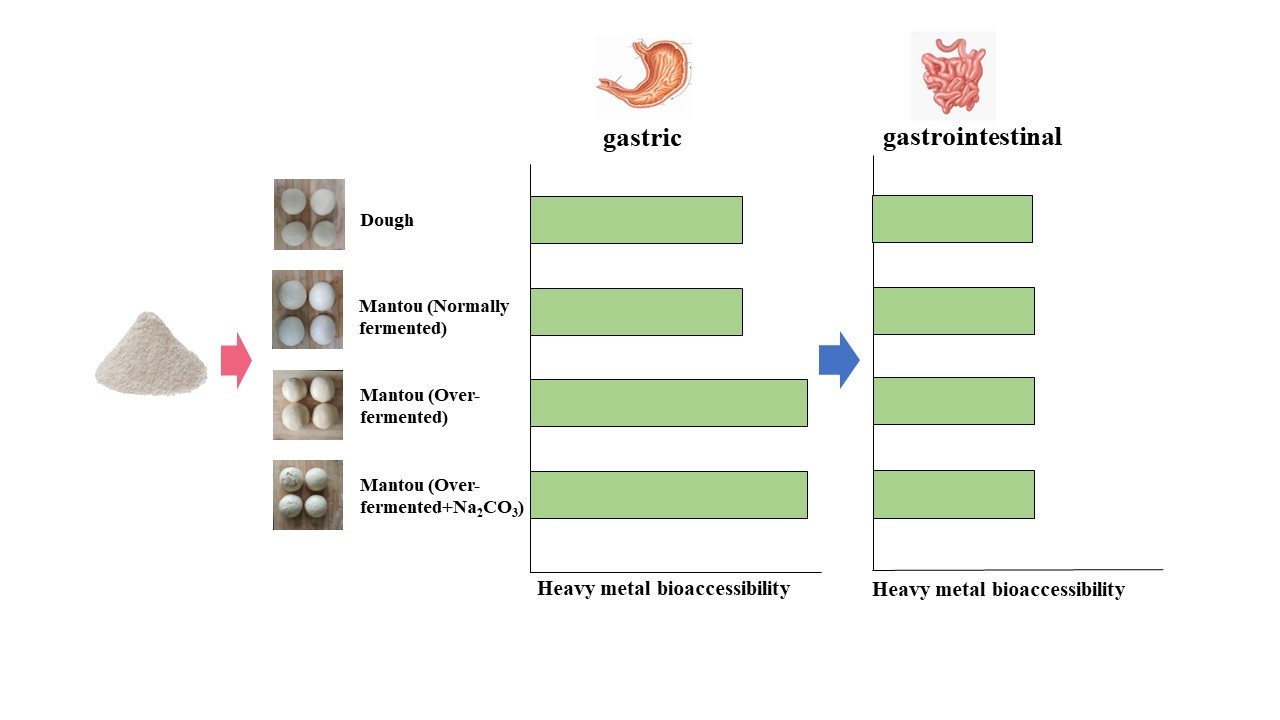Wheat (Triticum aestivumL.) is a worldwide staple food crop, with consumption contributing to human health by supplementing carbohydrates, protein, lipids, minerals, vitamins and cellulose. In China, wheat flour is made into numerous types of daily foods, including mantou (a bread-like food but steamed), baozi (like mantou, but having stuffing), noodles, bingzi (a baked flat bun, similar to pizza crust) and dumplings. Among all these wheat flour products, mantou is the dominant means by which wheat flour is consumed, especially in northern China. Chinese mantou, made with wheat flour, represents one of the most common foods for most residents in northern China. The preparation process of mantou starts with the mixing of wheat flour, water, and yeast or sourdough, followed by fermentation, molding and steaming. Wheat flour fermentation involves the cleavage of bonds in macromolecules like proteins and carbohydrates, transforming organic compounds and the subsequent release of ethanol, CO2and quantities of small molecules, resulting in fluffy and pleasant-tasting mantou.
Most metals present in wheat grain exist as a metal-phytate complex, which are low in solubility. Furthermore, humans lack phytase, and thus wheat consumption results in low absorption of trace elements and heavy metals in the human small intestine. Unfortunately, wheat flour fermentation can degrade phytate, resulting in elevated soluble metals in the dough, including Zn, Cu, Mg and Fe. Thus, different fermentation methods of heavy metal-contaminated wheat flour may result in different heavy metal solubilities in the final wheat product. However, effect of different fermentation methods on heavy metal bioaccessibilities in wheat flour is undetermined. In this work, gastric and gastrointestinal heavy metal bioaccessibility in wheat flour products (CK-wheat dough, T1-mantou made with normally fermented dough, T2-mantou made with over-fermented dough and T3-mantou made with over-fermented dough+Na2CO3) made from two wheat flour samples (NX and QD) was assessed via a modified physiologically-based extraction test. Cadmium, Zn and Mn bioaccessibility in the gastric phase (GP) was greater than in the gastrointestinal phase (GIP), yet the opposite was observed for Cu (p<0.05). Lead bioaccessibility in the GIP of the QD sample was 1.37 - 4.08 times greater than that in the GP, while only the CK had greater bioaccessibility in the GIP than that in the GP (p<0.05) for the NX sample. Treatments T2 and T3 had greater Cd, Cu, Zn and Mn bioaccessibilities than the CK and T1 in the GP (p<0.05). In the GIP however, only T3 had greater Mn bioaccessibility than the CK for the NX sample. Enhanced degradation of the heavy metal-phytate following over-fermentation may have led to greater heavy metal bioaccessibility. Results should help food processors reduce human absorption of excessive heavy metals present in wheat flour foods.
The lab work of this research was conducted by Miss Yanqing Liu, a graduate student of School of Environmental Engineering and the Joint Lab, with the advice by Professor Liping Li. Professor James A. Ippolito, professor of Colorado State University, USA and a member of the Joint Lab also contributed to the research. Results of this work was recently published in Environmental Science and Pollution Research recently (DOI: 10.1007/s11356-023-26727-6).
小麦是全球主要主食作物之一。小麦粉制成食品的主要加工过程包括和面、发酵、蒸、煮、烤、烙等过程。这些加工过程可能会影响其中所含重金属(包括微量营养元素)对人体的有效性。但这一点目前缺乏研究。“生态与环境修复中心”硕士研究生刘艳青在导师李立平教授指导下,对重金属污染小麦粉采用不同方法发酵并加工成馒头,之后采用体外模拟试验研究了正常发酵、过度发酵、加入碳酸钠等处理对小麦粉中所含镉、铅及微量营养元素铜、锌等在人体胃相和胃肠相的生物可给性。研究结果表明,面粉发酵方法影响馒头重金属的生物可给性,在大多数情况下,过度发酵处理和过度发酵+Na2CO3处理比对照和正常发酵处理具有更高的镉、铜、锌和锰生物可给性,这可能是由于在延长发酵条件下重金属-植酸盐复合物的水解更多;镉、锌和锰在胃相的生物可给性大于胃肠相,而铜和铅正好相反。研究结果可为控制小麦粉中重金属的健康风险、理解微量元素在小麦粉制作为食品过程中生物有效性的变化提供依据。
该研究成果以《Fermentation affects heavy metal bioaccessibility in Chinese mantou》(DOI: 10.1007/s11356-023-26727-6)为题,于近期发表于Environmental Science and Pollution Research(IF:5.190)上。环境工程学院李立平教授为该论文的通讯作者与第一作者,硕士研究生刘艳青为第二作者,河南工业大学及河南省环境污染修复与粮食质量安全国际联合实验室为该论文第一作者单位和通讯作者单位。国际联合实验室成员、美国科罗拉多州立大学James A. Ippolito教授对研究也有贡献。
撰稿:刘艳青 审校:李立平 审核:万东锦

研究的图形摘要Graphical abstract of the research
